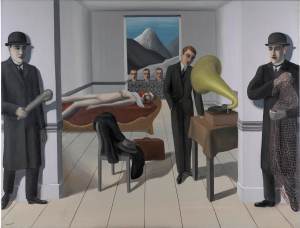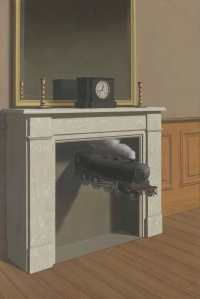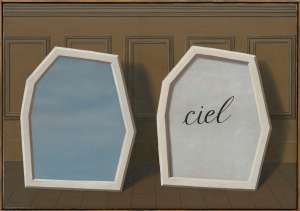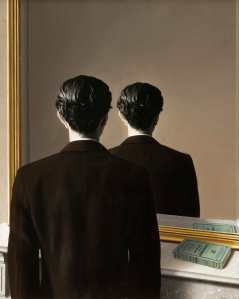by Paula Terán
New York, from 28. September 2013 to 12 January 2014
René Magritte (1898-1967) is probably the most famous Belgian artist of the 20th century, whose works have been massively used, adapted or imitated in advertisements, posters, albums or book covers, decorative objects etc., so that some of them have become authentic icons of the last century. As the Warhol’s prints of Marilyn or the Van Gogh’s Sunflowers.

Le faux miroir (The False Mirror), 1929, René Magritte. Oil on canvas. The Museum of Modern Art, New York.
He is considered as a Surrealist painter who usually represented a collection of ordinary objects in an unusual context or space (like a train coming out of a chimney, or a glass of water placed on an unbrella), giving new meanings to familiar things, and challenging the viewer preconditioned perceptions of reality and the ‘real world’ itself, in his words.
He would paint a simple object like a pipe or an apple and then write below ‘‘Ceci n’est pas une pipe’’ or ‘‘Ceci n’est pas une pomme’’ (‘‘This is not a pipe’’ or ‘‘This is not an apple’’), denying what was obvious to be seen. Only an apparent contradiction as indeed, he was pointing out that no matter how realistic the object represented seemed to be, the painting could never catch the pipe or the apple itself.
Magritte’s would describe his art as “visible images which conceal nothing; they evoke mystery and, indeed, when one sees one of my pictures, one asks oneself this simple question, ‘What does that mean?’. It does not mean anything, because mystery means nothing either, it is unknowable.”
![La trahison des images (Ceci n’est pas une pipe) (The Treachery of Images [This is Not a Pipe]), 1929, René Magritte. Oil on canvas. Los Angeles County Museum of Art, Los Angeles, California](https://museumexhibitions.files.wordpress.com/2013/09/moma_magritte_treacheryofimages_.jpg?w=300&h=223)
La trahison des images (Ceci n’est pas une pipe) (The Treachery of Images [This is Not a Pipe]), 1929, René Magritte. Oil on canvas. Los Angeles County Museum of Art, Los Angeles, California.
The Museum of Modern Art of New York, MoMA, will be presenting the exhibition ‘‘Magritte: The Mystery of the Ordinary, 1926-1938’’. It has been organized in collaboration with the Menil Collection in Houston and the Art Institute of Chicago, where it will be shown as well (at The Menil Collection between 14th February – 1st June, 2014, and at The Art Institute of Chicago between 29th of June -12th October 2014).
The retrospective is focused on Magritte’s essential works from the 1920’s and 1930‘s, and shows over 80 paintings, collages, drawings, and objects, along with a selection of photographs, periodicals, and early commercial work, exploring and tracing his development as a definitive Surrealist painter. In addition to works from MoMA’s collection, the exhibitions includes many loans from public and private collections all over the world.

L’assassin menacé (The Menaced Assassin), 1927, René Magritte. Oil on canvas. Museum of Modern Art, New York.
It also follows Magritte to Paris, where he lived from 1927 to 1930, essential years where he met Surrealists like André Breton, Salvador Dalí, and Joan Miró, and created his first word-image paintings. At that moment, his art was at times violent and disturbing. He started then using methods that included the misnaming of objects, doubling, repetition and mirroning. Some of Magritte’s most radical and famous works are from that period in Paris.
Paintings like ‘’The Lovers’’ (1928) where he invokes de cliché of a close-up kiss, but radically changing the voyeuristic side of the image by covering the faces with a cloth. Or ‘’The Treachery of Images ‘’(1929) representing the ‘‘Ceci n’est pas une pipe’’ pipe, or the female nude ‘‘The Eternally Obvious’’ (1930). These paintings will be shown together in this exhibition for the first time since 1931.
In 1930 he returned to Brussels where he continued searching for new forms of image making and created paintings that depicted disturbing and unexpected associations between objects.
The exhibitions ends in 1938, just before the outbreak of the Second World War and the year Magritte delivered an important retrospective account of what had made him a Surrealist painter.
As usual, some useful information for your visit:
- Museum of Modern Art, MoMA website: http://www.moma.org/
- Dates and opening hours for the exhibition: from 28 September 2013 to 12 January 2014. Monday to Sunday from 10.30h to 17.30h; Friday from 10.30h to 20.00h.
- Ticket Prices and Sales: General: 25$; Children up to 16: free.
****************************************************************************************************************
The Museum of Modern Art (MoMA): ‘Magritte: El Misterio de lo Ordinario, 1926-1938’, del 28. Septiembre 2013 al 12. Enero 2014.
René Magritte (1898-1967) es seguramente el más famoso artista belga del siglo XX, cuyas obras han sido masivamente utilizadas, adaptadas o imitadas en pósters publicitarios, portadas de álbumes o libros, objetos decoraticos, etc., de manera que algunas de sus imágenes se han convertido en auténticos iconos del pasado siglo. De la misma manera que las serigrafías sobre Marilyn de Warhol, o los Girasoles de Van Gogh.

La condition humaine (The Human Condition), 1933, René Magritte. Oil on canvas. National Gallery of Art, Washington.
Magritte es considerado como un pintor Surrealista que frecuentemente representaba una colección de objetos ordinarios en un contexto o espacio no habitual (como un tren que sale de una chimenea, o un vaso de agua colocado sobre un paraguas), dando un nuevo significado a las cosas familiares, y desafiando las percepciones precondicionadas del espectador hacia la realidad. Desafiando el propio ‘mundo real’, según sus propias palabras.
Así, llegaría a pintar un simple objeto como una pipa o una manzana, escribiendo debajo ‘‘Ceci n’est pas une pipe’’ o ‘‘Ceci n’est pas une pomme’’ (‘‘Esto no es una pipa’’ o ‘‘Esto no es una manzana’’), negando lo que era obvio a la vista. Sin embargo se trataba sólo de una contradicción aparente ya que lo que Magritte señalaba era precisamente que no importaba lo realista que la representación del objeto fuera, la obra nunca podría alcanzar la propia pipa o manzana.
Magritte describía su arte como ”imágenes visibles que no esconden nada; evocan misterio y, efectivamente, cuando uno ve mis cuadros se pregunta esta simple cuestion: ”Qué quiere decir?’. No quiere decir nada, porque el misterio no significa nada tampoco, es inescrutable’.

La durée poignardée (Time Transfixed), 1938, René Magritte. Oil on canvas. The Art Institute of Chicago, Chicago.
El Museo de Arte Moderno de Nueva York, MoMA, presenta la exposición ”Magritte: El Misterio de lo Ordinario, 1926-1938”, organizada en colaboración con la Colección Menil de Houston y el Instituto de Arte de Chicago, donde también se expondrá posteriormente (en la ‘Menil Collection’ entre el 14 de febrero y el 1 de junio del 2014, y en el ‘Art Institute of Chicago’ entre el 29 de junio y el 12 de octubre del 2014).
La retrospectiva se centra en las obras más relevantes de Magritte de los años 20 y 30, y muestra alrededor de 80 cuadros, además de collages, dibujos y objetos, junto a una selección de fotografías y artículos, explorando y rastreando el desarrollo del pintor Surrealista. Además de las obras de la propia colección del MoMA, la exposición incluye también numerosos préstamos de colecciones públicas y privadas de todo el mundo.
Cronológicamente la exposición comienza en 1926, con las pinturas y los collages que Magritte realizó en Bruselas, los cuales, según sus propias palabras, ”retaban el mundo real” y que le proporcionaron el reconocimiento como pintor Surrealista.
Sigue también a Magritte en París, donde vivió entre 1927 y 1930, años esenciales donde conoció a Surrealistas como André Breton, Salvador Dalí, y Joan Miró, y donde creó sus primeras pinturas ‘palabra-imagen’. Su obra en ese momento es en ocasiones violenta y perturbadora. Comenzó también a utlizar métodos que incluirían llamar a los objetos por otro nombre, duplicación, repetición y utilización de imágenes-espejo.
Algunos de las más radicales y famosas obras de Magritte son de ese periodo parisino. Obras como ”Los Amantes” (1928) donde invoca el cliché de un primer plano de un beso, pero cambiando de manera radical la vertiente voyerista de la imagen, mediante la colocación de un paño sobre los rostros que se besan. O ”La Traición de las Imágenes” (1929) representando la pipa ”Ceci n’est pas une pipe’’, o el desnudo femenino ”Lo Eternamente Obvio” (1930). Todos estos cuadros se van a mostrar juntos en esta exposición por primera vez desde 1931.

Le Palais de rideaux, III (The Palace of Curtains, III), 1928-29, René Magritte. Oil on canvas. Museum of Modern Art, New York.
La muestra finaliza su recorrido en 1938, justo antes del comienzo de la II Guerra Mundial, y momento más revelador de la obra de Magritte, que le llevó a ser considerado un pintor Surrealista.
Como es habitual, aquí se incluye alguna información útil para la visita:
- Página web del Museo de Arte Moderno, MoMA: http://www.moma.org/
- Fechas y horario de apertura de la exposición: del 28 de septiembre del 2013 al 12 de enero del 2014. De lunes a domingo de 10.30h a 17.30h; viernes de 10.30h a 20.00h.
- Tarifas y venta de entradas: General: 25$; menores hasta los 16 años: entrada gratuíta.


